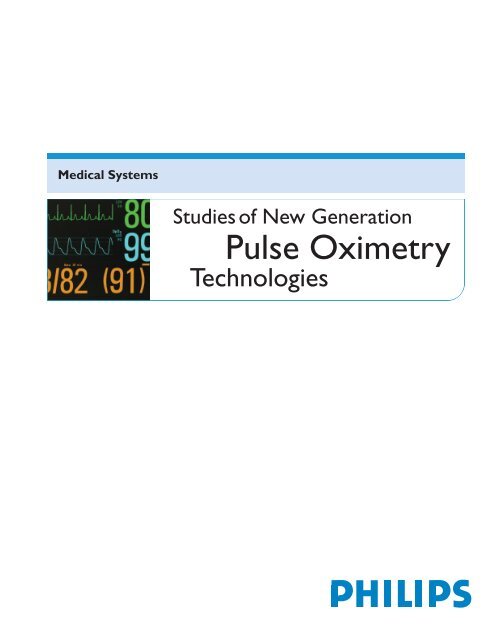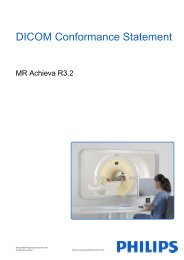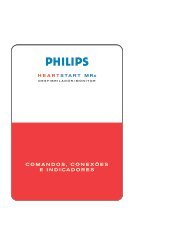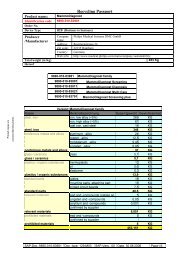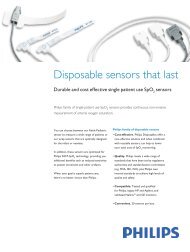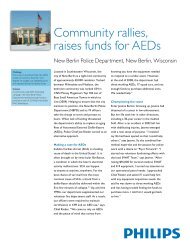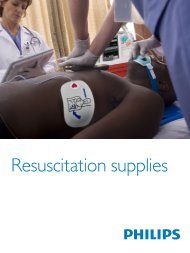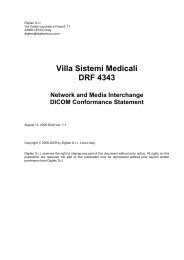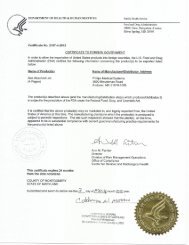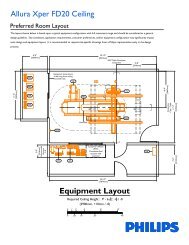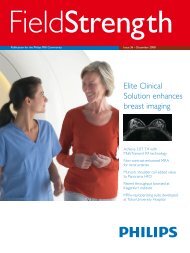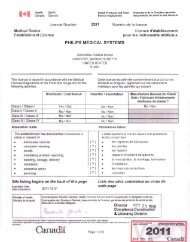Pulse Oximetry - Philips
Pulse Oximetry - Philips
Pulse Oximetry - Philips
Create successful ePaper yourself
Turn your PDF publications into a flip-book with our unique Google optimized e-Paper software.
Medical Systems<br />
Studies of New Generation<br />
<strong>Pulse</strong> <strong>Oximetry</strong><br />
Technologies
<strong>Philips</strong> FAST SpO 2 (Fourier Artifact<br />
Suppression Technology) is compatible with the widest<br />
array of sensors in the industry. It uses a patented<br />
frequency analysis algorithm to filter out noise in the<br />
sensor signal, thereby overcoming many of the issues<br />
associated with traditional pulse oximetry, such as<br />
sensitivity to patient movement or intense ambient light.<br />
Many studies have been conducted comparing the<br />
various SpO2 technologies.This guide includes<br />
summaries of some of those studies and is meant to<br />
help you better understand how <strong>Philips</strong> FAST SpO2 performs against other technologies in the marketplace<br />
and why <strong>Philips</strong> FAST SpO2 is still a smart choice.
Table of Contents<br />
Integrated Review of SpO 2 Studies<br />
New Generation <strong>Pulse</strong> <strong>Oximetry</strong> in the Care of Critically Ill Patients; 7<br />
American Journal of Critical Care, January 2005,Volume 14, No. 1<br />
Study Summaries<br />
References 17<br />
ADULT New-Generation <strong>Pulse</strong> <strong>Oximetry</strong> in the Care of Critically Ill Patients 5<br />
How Reliable are the New Generation <strong>Pulse</strong> Oximeters in the 19<br />
Detection of Hypoxemia in the Intensive Care Unit?<br />
The Clinical Use of Two New Generation SpO 2 Devices for Critically Ill 20<br />
Patients with Sepsis<br />
A Comparison of the Accuracy of the <strong>Philips</strong> FAST and Masimo SET 21<br />
<strong>Pulse</strong> Oximeter Following Cardiac Surgery<br />
A Comparison of Three New Generation SpO 2 Devices During Ambulation 22<br />
After Open Heart Surgery<br />
“Motion-Resistant” <strong>Pulse</strong> <strong>Oximetry</strong>: A Comparison of New and Old Models 23<br />
NEONATE The Clinical Use of Two New Generation SpO 2 Devices for Patients 24<br />
in the Neonatal Intensive Care Unit (NICU)<br />
2 3
General Review<br />
New-Generation <strong>Pulse</strong> <strong>Oximetry</strong> in the<br />
Care of Critically Ill Patients<br />
Karen K. Giuliano, RN, PhD, and Thomas L. Higgins, MD, MBA; Boston College William F. Connell School<br />
of Nursing, Chestnut Hill, Mass (KKG), <strong>Philips</strong> Medical Systems, Andover, Mass (KKG), the Adult Critical<br />
Care Division Baystate Medical Center, Springfield, Mass (TLH), and Tufts University School of Medicine,<br />
Boston, Mass (TLH). American Journal of Critical Care, January 2005,Volume 14 No. 1<br />
• The objective of this article was to review the published, peer-reviewed studies that have been done on the newgeneration<br />
pulse oximeters, which are manufactured with algorithms to filter out patients’ body motions. In addition<br />
this article also describes the application of new-generation pulse oximetry in clinical practice in critical care.<br />
• A total of 17 articles were found in MEDLINE from 1995 to 2003. Each article was examined for scientific merit,<br />
content, and applicability to clinical practice.<br />
• A consistent finding among the studies that were reviewed was the superior performance with regard to reduction<br />
in frequency of false alarms and overall accuracy of all the new motion-tolerant devices compared with the<br />
performance of the various conventional pulse oximeters. However, more clinical evidence on the performance of<br />
new-generation pulse oximetry devices is clearly needed, particularly in the setting of critical care. Although some<br />
conclusions can be made, a lack of consistency among study variables and techniques and discrepancies between<br />
the results of the studies reviewed, make it difficult to make any overall recommendations about which of the<br />
new-generation motion-tolerant devices are best suited for use in critical care in any of the populations of patients<br />
studied. Clearly, more clinical trials are needed before the most accurate and reliable motion-tolerant pulse oximetry<br />
device can be determined for use in populations of critically ill patients.These trials should address the performance<br />
of the algorithms used for obtaining SpO 2 values in critically ill patients of all ages in situations in which patients’<br />
movements are a factor. In addition, each trial should clearly specify which software revisions are being used with<br />
each device and should include a comparison with a known gold standard (preferably co-oximetry) for measurement<br />
of oxygen saturation. Additionally, the variables of peripheral temperature, finger thickness, hemoglobin concentration,<br />
and skin color should be part of every future study on measurement of oxygen saturation by pulse oximetry devices<br />
to further assess the significance of these variables on clinical measurement of SpO 2 .<br />
Complete article follows.<br />
4 5
AMERICAN JOURNAL OF CRITICAL CARE January 2005,Volume 14, No. 1<br />
New-Generation <strong>Pulse</strong> <strong>Oximetry</strong> in the<br />
Care of Critically Ill Patients<br />
By Karen K. Giuliano, RN, PhD, and Thomas L. Higgins, MD, MBA. From the Boston College William F.<br />
Connell School of Nursing, Chestnut Hill, Mass (KKG), <strong>Philips</strong> Medical Systems, Andover, Mass (KKG), the<br />
Adult Critical Care Division, Baystate Medical Center, Springfield, Mass (TLH), and Tufts University School<br />
of Medicine, Boston, Mass (TLH).<br />
Objective: To review the published, peer-reviewed studies to date on use of the new-generation pulse<br />
oximeters, which are manufactured with algorithms to filter out patients’ body motions, and describe the application<br />
of new-generation pulse oximetry in clinical practice in critical care.<br />
Methods: MEDLINE was used to locate appropriate articles on pulse oximetry for the years 1995 to 2003.<br />
Each article was examined for scientific merit, content, and applicability to clinical practice.<br />
Results: A total of 17 relevant articles on the clinical performance of the new-generation pulse oximeters were<br />
reviewed, and the data were organized into a table.<br />
Conclusions: The combination of studies done in both clinical and laboratory settings did not provide any<br />
strong and convincing evidence that the performance of any single new-generation device was superior to that<br />
of any other new-generation device. However, the clinical performance of all the new generation pulse oximetry<br />
devices was better than that of earlier devices. (American Journal of Critical Care. 2005; 14:26-39)<br />
Monitoring of oxygen saturation is important in the contemporary healthcare environment and is widely regarded as one of the<br />
most important advances in clinical monitoring. In fact, Hanning and Alexander-Williams 1 described it as “the greatest advance in<br />
patient monitoring since electrocardiography.” Before 1980, the most common way to monitor patients continuously for hypoxemia<br />
was through physical assessment of the skin for cyanosis. However, the clinical detection of cyanosis is subjective and unreliable, and<br />
cyanosis is a late sign of hypoxemia. Oxygen saturation generally must decrease to 80% to 85% before any changes in skin color can<br />
be detected. 2<br />
Continuous monitoring of oxygen saturation via pulse oximetry is a standard of care for use in the operating room, postanesthesia<br />
care unit (PACU), critical care unit, emergency department, and environments in which conscious sedation is used. 3,4 As the<br />
acuity level of hospitalized patients increased during the past 10 years, so too did the need for oxygen saturation monitoring<br />
outside critical care areas.<br />
The first commercially available pulse oximeter was developed by Takuo Aoyagi and was marketed by Nihon Koden in 1974. 5<br />
However, both this first pulse oximetry device and the Oximet marketed by Minolta in 1977 were considered primarily research<br />
devices.The first pulse oximetry device manufactured for routine clinical use was the Nellcor N-100. It was initially marketed in<br />
1982 and became the standard conventional pulse oximeter. 5 Those first conventional oximeters made it possible to measure<br />
oxygen saturation as a continuous parameter and, as a result, were rapidly adopted for use in surgery to prevent the estimated<br />
40% of accidental deaths that were due to decreases in oxygen saturation. 5 However, outside the operating room, patients’ body<br />
motions became a major technical challenge, because the motions interfere with the ability of conventional pulse oximeters to<br />
obtain an accurate measurement.<br />
Republished with permission of the Journal of Critical Care, from New-Generation <strong>Pulse</strong> <strong>Oximetry</strong> in the Care of Critically Ill Patients,<br />
Karen K. Giuliano, RN, PhD, and Thomas L. Higgins, MD, MBA from the Boston College William F. Connell School of Nursing, Chestnut Hill, Mass (KKG),<br />
<strong>Philips</strong> Medical Systems,Andover Mass (KKG), the Adult Critical Care Division, Baystate Medical Center, Springfield, Mass (TLH), and Tufts University<br />
School of Medicine, Boston, Mass (TLH),Volume 14, No.1, 2005); permission conveyed through Copyright Clearance Center, Inc.”<br />
2 7
AMERICAN JOURNAL OF CRITICAL CARE January 2005,Volume 14, No. 1<br />
Motion artifact occurs either when a patient’s movements cause the pulse oximeter to incorrectly interpret the movements as a<br />
pulse signal or when the motion artifact prevents accurate detection of the patient’s true pulse signal.The resultant increase in<br />
false alarms and erroneous measurements can desensitize clinicians to the alarms and increase the chance of missing a clinically<br />
important true alarm. 6-8<br />
Patients’ motion decreases accuracy of conventional pulse oximeters<br />
and has led to the development of “motion tolerant” oximeters.<br />
Manufacturers of pulse oximeters have sought to reduce motion artifact in the pulse signal through improvements in the algorithms.<br />
“Motion tolerant” pulse oximetry devices are now commercially available from several different manufacturers, and as a group are<br />
referred to as “new generation” pulse oximeters.To date, peer-reviewed scientific publications on evaluations of these new-generation,<br />
motion-tolerant devices are few and are primarily limited to 3 of the devices currently on the market: FAST SpO 2 (Fourier artifact<br />
suppression technology SpO 2 ; <strong>Philips</strong> Medical Systems, Andover, Mass; first marketed in 1999), SET (signal extraction technology;<br />
Masimo Corp, Irvine, California; first marketed in 1998), and Oxismart (Nellcor, Pleasanton, California; first marketed in 1994).<br />
Review of the Literature<br />
MEDLINE was used to identify research studies on the new-generation motion-tolerant pulse oximetry products published in<br />
English during the period 1995 through 2004.The search terms “oxygen saturation,”“pulse oximetry,”“SpO 2 ,” and “oxygen measurement”<br />
were used. Even though many articles on pulse oximetry in general have been published, the focus of most of the articles<br />
was conventional pulse oximetry. In this state-of-the-science review, we focus solely on data-based studies on the performance of<br />
the new-generation pulse oximetry devices during patients’ movements. Although we also reviewed some data on the performance<br />
of the devices in patients with low perfusion, that aspect was not our focus.We found 17 research studies in which investigators<br />
specifically examined the performance of new-generation devices; these studies are listed and described in the Table.<br />
Several problems in the published studies made interpretation and/or generalization of the findings difficult. First, various software<br />
revisions of each manufacturer’s algorithms for measuring oxygen saturation were used, often making the comparisons somewhat<br />
of an apples-and-oranges approach. Second, even when pulse oximetry devices with the same brand name were used, most<br />
authors did not fully disclose the actual software revision or signal averaging times used during the testing, making meaningful<br />
comparisons between studies even more difficult.Third, studies were characterized by different evaluation criteria, limited evaluation<br />
criteria, inadequate description of how device performance was evaluated, or poor study design. Last, Dumas et al. 26 evaluated a<br />
prototype that was never released commercially; that study, therefore, was excluded from this review. Comparisons, findings,<br />
strengths, and weaknesses of the reviewed studies are outlined in the Table.<br />
Laboratory Studies<br />
The performance of new-generation pulse oximetry devices was evaluated in a laboratory setting in 5 studies. 9,14,16,17,19<br />
The advantages of doing any kind of clinical study in a laboratory rather than a real clinical setting are generally lower cost and<br />
more control over the variables.The major problem, however, is the difficulty of replicating the characteristics of a clinical setting 16 ,<br />
especially when the clinical setting is as complex as critical care. Additionally, in 4 of the 5 studies, the subjects were healthy<br />
volunteers, whose clinical conditions and oxygen saturation measured by pulse oximetry (SpO 2 ) often bear little resemblance<br />
to those of critically ill patients. 9,14,16,19<br />
One approach usually referred to as the “steadystate reference hand” was used in 2 of the studies. 9,17 With this approach, the<br />
subject keeps one hand still and the other hand is strapped to a motion arm that is programmed to move in various patterns.<br />
The SpO 2 readings of the moving hand are then compared with the readings of the nonmoving reference hand.The disadvantage<br />
of this approach is that passive motion is used, a kind of motion that has little relevance to clinicians because these simulated<br />
passive motions do not mimic the active motion most common in patients in actual clinical settings. 27 Therefore, the use of this type<br />
of testing is a significant flaw when used in studies to compare the performance of pulse oximetry devices, a flaw that has<br />
been recognized by other researchers. 16<br />
8 3
AMERICAN JOURNAL OF CRITICAL CARE January 2005,Volume 14, No. 1<br />
Summary of research findings, strengths, weaknesses, and limitations of studies on motion-tolerant pulse oximetry devices<br />
STUDY DEVICES PATIENTS<br />
Barker and Shah9 • Masimo SET (MT): experimental prototype<br />
• Nellcor N-3000 (MT) with variable signal averaging time<br />
• Nellcor N-200 (CPO)<br />
10 healthy adult volunteers in a laboratory setting<br />
Bohnhorst et al10 • Masimo SET (MT) in 8-second signal averaging mode<br />
• Nellcor N-3000 (MT) with variable signal averaging time<br />
• Nellcor N-200 (CPO) in 6- to 7-second signal-averaging mode<br />
17 patients in a NICU<br />
Brouillette et al11 Part I Part I<br />
• Masimo SET (MT) in 4-second signal averaging mode 24 children referred to a sleep apnea laboratory<br />
• Nellcor N-200 (CPO) in 2- to 3-second signal-averaging mode<br />
• Nellcor N-395 in 2- to 3-second signal-averaging mode<br />
• Transcutaneous oxygen probe (no model given)<br />
because of sleep disordered breathing<br />
Part II Part II<br />
• Masimo Radical in 2-second signal averaging mode (MT) 22 children referred to a sleep apnea laboratory<br />
• Nellcor N-200 (CPO) because of sleep disordered breathing<br />
Durbin and Rostow12 • Masimo SET (MT) 13 patients with thoracic and cardiovascular<br />
• Arterial blood gas sample conditions in an ICU<br />
Durbin and Rostow13 • Masimo SET (MT)<br />
• Ohmeda 3740 (CPO)<br />
59 adult cardiac surgery patients<br />
Gehring et al14 • <strong>Philips</strong> FAST SpO2 (revision B.0; MT)<br />
• Masimo SET (MT)<br />
• Nellcor N-395 (MT)<br />
• Datex-Ohmeda 3900P (MT)<br />
• Nellcor N-3000 (MT, but older than N-395)<br />
10 healthy volunteers in a laboratory setting<br />
Hay et al15 • Masimo SET (MT) Part 1<br />
• Nellcor N-395 (MT) 26 infants in a NICU<br />
• MARSpO2 (MT)<br />
• <strong>Philips</strong> FAST SpO2 (Virida 24C; MT)<br />
• Nellcor N-200 (CPO)<br />
Part II<br />
7 infants in a NICU<br />
Jopling et al16 • Nellcor N-395 (MT) 8 subjects (the characteristics of subjects<br />
• Masimo SET (MT)<br />
• NPB-290<br />
were not described)<br />
Kastle and Konecny17 • <strong>Philips</strong> M3 (revision B) FAST SpO2 (MT) Output signals derived from patients were<br />
• Ivy 2000 (revision 2.2) with Masimo SET (MT)<br />
• Nellcor N-3000 (revision 3.03; MT)<br />
• <strong>Philips</strong> CMS (revised A.0; CPO)<br />
used in a laboratory benchmark study<br />
Kopotic and Linder18 Part I Part I<br />
• Ohmeda 2000 with Masimo SET (MT)<br />
• Nellcor N-295 with Oxismart (MT)<br />
50 newborns at high risk for respiratory failure<br />
Part II Part II<br />
• Radical with Masimo SET (MT) 15 neonates
AMERICAN JOURNAL OF CRITICAL CARE January 2005,Volume 14, No. 1<br />
Approaches in which active motion is used to test pulse oximetry devices have also been described. 14,16,17 Both Jopling et al 16 and<br />
Gerhing et al 14 used healthy volunteers but devised active-motion protocols of tapping and scratching motions with a wide variety<br />
of amplitudes and velocities. A noteworthy weakness of these studies is that both had small sample sizes (Jopling et al, N=8;<br />
Gehring et al, N=10). In addition to motion, the devices in these studies were tested during conditions of hypoxemia and low<br />
perfusion. Jopling et al induced hypoxemia in the healthy subjects and thus obtained a range of oxygen saturations of 70% to 100%<br />
during the active-motion testing, which provided a much closer approximation to the range of SpO 2 values that might occur in a<br />
real clinical setting. Gehring et al simulated low perfusion by compressing the brachial artery.The overall findings for the detection<br />
of hypoxemia of both of these studies indicated that the performance of the new-generation devices was better than that of<br />
the conventional devices.When the new-generation devices were compared with one another, differences in the detection of<br />
hypoxemia were not significant.<br />
FINDINGS COMMENTS<br />
Masimo SET had the best overall performance, with 99% accuracy and a<br />
positive predictive value of 100%<br />
N-200 had the greatest number of errors in SpO2 values, an overall accuracy of<br />
76%, and a positive predictive value of 73%<br />
N-3000 had the greatest dropout rates, an overall accuracy of 87%, and a<br />
positive predictive value of 81%<br />
Masimo SET missed 1 hypoxemic event (0.5%)<br />
N-3000 missed 10 hypoxemic events (5.4%)<br />
N-200 did not miss any hypoxemic events, but had the highest rate of dropouts<br />
Part I<br />
Simultaneous readings from an MT device and a CPO were compared during<br />
20 randomly selected desaturation events of >_4%<br />
With the N-200, 88% of 220 desaturations were detected during wakefulness,<br />
and 38% of 194 desaturation events during sleep were classified as motion artifact<br />
With the Masimo Q 400 and the transcutaneous oxygen probe, no desaturation<br />
events were detected<br />
A total of 119 desaturation episodes during sleep were detected by all 3 devices<br />
Part II<br />
Newer version MT was compared with CPO for detection of true desaturations<br />
Masimo Radical device detected significantly more nonartifactual desaturation<br />
events during sleep than the N-200 did<br />
Performance of an MT device was evaluated in patients whose CPO did not<br />
acquire a reliable signal<br />
Masimo SET was able to obtain a reliable signal in 12 of 13 patients; the patient<br />
in whom the signal could not be detected had hypotension, poor peripheral<br />
perfusion, and shivering and was being treated with intra-aortic balloon pumping<br />
The difference between direct measurement of SaO2 and the Masimo SET value<br />
was 1.1% (±1%)<br />
Two thirds of saturation values were >94%<br />
Researchers measured amount of data dropout, artifact, or when SpO2 readings<br />
differed from arterial blood gas results by more than 10%<br />
With patients randomly assigned to groups, the Masimo SET was significantly<br />
more reliable than was the CPO<br />
Patients with the Masimo SET were weaned to a fraction of inspired oxygen<br />
of 0.40 more quickly and had fewer arterial blood gas analyses than did the<br />
patients with the CPO<br />
The 2 groups did not differ in time to extubation<br />
<strong>Pulse</strong> oximetry with new-generation devices was compared with other technologies<br />
Signal-averaging times were not specified<br />
Only passive motion was tested<br />
The hand with the Masimo SET device was used as the reference hand<br />
The non-motion hand was sometimes moving<br />
Signal-averaging time for the N-200 was not specified<br />
No data were reported on overall frequencies of false alarms<br />
No gold standard reference was used<br />
Parts I and II<br />
Signal-averaging settings given in the abstract do not agree with<br />
those in the text<br />
No gold standard reference was used to verify oxygen saturations<br />
measured by the devices<br />
Data on the accuracy of transcutaneous oxygen monitoring<br />
in children and adults were limited but theoretically are of<br />
concern because of increased skin thickness in patients other<br />
than neonates<br />
The “Methods” section lacked detail on the time from application<br />
of the MT device until a reliable signal was obtained<br />
The small sample size limits generalization of the findings<br />
Most of the patients had normal SaO2 during the study period<br />
The results may not be applicable to other populations of patients<br />
Only 59 of 86 patients had enough complete data for analysis<br />
Clinicians were not blinded to which oximeter was being used<br />
No gold standard was included for comparison of oximeter readings<br />
<strong>Pulse</strong> <strong>Oximetry</strong> with new generation devices was compared with<br />
other technologies<br />
Signal-averaging times were not specified<br />
10 3
AMERICAN JOURNAL OF CRITICAL CARE January 2005,Volume 14, No. 1<br />
In a lab setting, all new-generation pulse oximeters outperformed conventional devices<br />
in their ability to tolerate motion.<br />
Kastle and Konecny 17 used an approach referred to as noise-mix-composition. In this approach, 136 different combinations of<br />
raw patient-generated signals from the operating room, the intensive care unit, and the PACU were used.The range of oxygen<br />
saturation in the signals was 39% to 100% (mean 89.9%; SD 10.7%), and the range of pulse rates was 49/min to 201/min (mean<br />
108.2/min; SD 45.9/min).These signals were then fed digitally into each of the pulse oximeters being studied.The advantage of<br />
this approach is that real, not simulated, signals were used. In addition, a wide range of both oxygen saturations and pulse rates were<br />
used to test the pulse oximeters.This range of values more closely approximated the types of clinical phenomena encountered in<br />
the critical care setting.<br />
In general, the overall results of the 5 laboratory studies were consistent. In studies in which passive motion was used, the Masimo<br />
SET device tended to have the best performance, whereas in studies in which active motion was used, the Nellcor and <strong>Philips</strong><br />
devices tended to have the best performance. For example, in the study by Kastle and Konecny, 17 the Masimo device had the<br />
best performance (2.6-fold improvement over conventional pulse oximeters compared with 1.6-fold improvement for both<br />
<strong>Philips</strong> and Nellcor) during the steady-state reference hand, passive-motion part of the testing. In contrast, during the noise-mixcomposition,<br />
active-motion part of the study, the <strong>Philips</strong> device had the best performance (1.6 fold improvement compared with<br />
1.5-fold for the Masimo device and 1.3-fold for the Nellcor device). However, none of these differences were clinically significant.<br />
In 4 of the 5 laboratory studies, conventional devices were used as one means of comparison. 9,14,17,19 A consistent and important<br />
finding of these 4 studies was that regardless of the differences in measurement criteria, the performance of all the new-generation<br />
pulse oximetry devices was better than the performance any of the conventional devices to which they were compared.<br />
2 11
AMERICAN JOURNAL OF CRITICAL CARE January 2005,Volume 14, No. 1<br />
FINDINGS COMMENTS<br />
Researchers used the N-3000 as a reference oximeter and looked at errors in<br />
both pulse rate and SpO2 During desaturation events, all the devices were within 3% of the reference<br />
reading 95% of the time<br />
With either low perfusion or motion, all the devices were within 3% of the<br />
reference reading 75%-85% of the time<br />
During both low perfusion and motion, all the devices were within 3% of the<br />
reference reading less than 62% of the time<br />
The Masimo SET, <strong>Philips</strong> FAST SpO2 , and N-395 devices did not differ significantly<br />
in overall performance<br />
Large errors (significant) occurred only between the N-3000 and the N-395<br />
during both motion and low perfusion<br />
Part I<br />
The Masimo SET was compared with the N-200 CPO<br />
The Masimo was better than the N-200 for false hypoxemias, false bradycardias,<br />
total false alarms, data dropout, and true bradycardias<br />
Part II<br />
The 3 new-generation devices were compared with one another<br />
The Masimo SET was better than the other new-generation devices for false<br />
hypoxemias, desaturations, and data dropout<br />
The performances of the Masimo SET, the N-395, and the <strong>Philips</strong> FAST SpO2 were better than the performance of the MARSpO2 for false bradycardias<br />
Different testing methods (active and passive [machine generated] motion)<br />
were compared in subjects with various levels of hypoxemia-induced states<br />
(SaO2 , 70%-100%) during a 2- to 3-minute period<br />
The performances of the N-395 and the Masimo SET were better than the<br />
performance of the N-290 in both active- and passive-movement tests<br />
Steady-state reference hand part<br />
The performance of each of the 3 new-generation devices was better than<br />
that of the CPO: 2.6-fold improvement over the CPO for the Masimo SET and<br />
1.6-fold improvement for the <strong>Philips</strong> FAST SpO2 and the Nellcor N-3000<br />
Noise-mix-composition part<br />
The performance of each of the 3 new-generation devices was better than that<br />
of the CPO: 1.6-fold improvement over the CPO for the <strong>Philips</strong> FAST SpO2 ,<br />
1.5-fold for the Masimo SET, and 1.3-fold for the Nellcor<br />
Compression of the brachial artery was used to simulate low<br />
perfusion, which is probably not representative of low perfusion<br />
in the real clinical setting<br />
The sample size was small<br />
The N-3000 was used as the reference oximeter for all the devices<br />
The software revision for the <strong>Philips</strong> device was not given, so it is<br />
uncertain whether the device is really an MT device or a CPO<br />
No gold standard was used to assess the accuracy of the SpO2 values for any of the devices<br />
The methods used and results lacked clarity and sufficient detail<br />
for adequate evaluation of the study<br />
The laboratory situation may not adequately reflect motion in<br />
clinical practice<br />
The sample size was small<br />
The charts and graphs in the article supply a level of detail that<br />
is sometimes difficult to follow<br />
12 3
AMERICAN JOURNAL OF CRITICAL CARE January 2005,Volume 14, No. 1<br />
Clinical Studies in Adults<br />
Real clinical environments and adult patients were used to assess the performance of new-generation pulse oximeters in<br />
6 studies. 12,13,20,23-25 The new generation devices included the Masimo SET, Nellcor N-3000, and <strong>Philips</strong> FAST SpO 2 .The clinical<br />
areas included the operating room, 23,25 the PACU, 20,24,25 and the critical care unit. 12,13,20 Because patients’ movements should not<br />
be a factor in the operating room, we considered studies done in the operating room separately from those done in the PACU<br />
or critical care unit.<br />
The new-generation devices used in the operating room included the Nellcor N-3000 and the <strong>Philips</strong> FAST SpO 2 . In the first study,<br />
Rheineck-Leyssius and of the N-3000 with a 5- to 7-second signal averaging time and the performance of a conventional pulse<br />
oximetry device with a 21-second signal-averaging time.<br />
None of the new-generation oximeters differed from the other in clinical performance.<br />
Signal-averaging time for pulse oximeters represents the amount of time (in seconds) used by the device to calculate the displayed<br />
SpO 2 value.The shorter the signal-averaging time, the more sensitive the device will be to changes in the SpO 2 value. However,<br />
the device will also be more prone to false alarms due to artifact or error. Conversely, as the signal-averaging time is increased,<br />
the number of alarms due to error or artifact is decreased, but the amount of time needed to detect a true hypoxemia is<br />
concomitantly increased, because the SpO 2 values are averaged over a longer period.<br />
Hence, the results of the study 23 are not surprising because patients’ movements should not be a factor in the operating room.<br />
Furthermore, a 21-second signal averaging time on the conventional comparison device would obscure most of the signal artifact<br />
because the signal is averaged over such a long period. In contrast, in most of the new-generation devices, signal-averaging times<br />
are less than 10 seconds.This decrease in time enhances detection of hypoxemia, and, at the same time, the improved algorithms<br />
are better able to filter out motion artifacts due to patients’ movements, thus helping to control for the increase in false alarms<br />
that accompany decreased signal-averaging times with conventional pulse oximetry.<br />
Factors that influenced oximeters’ degree of error were peripheral temperature,<br />
finger thickness, hemoglobin concentration, and skin color.<br />
In the second study done in the operating room,Wouters et al 25 used a total of 2694 SpO 2 recordings in 1483 patients and<br />
compared the measurement accuracy of the <strong>Philips</strong> FAST SpO 2 and the Nellcor N-3000.Values obtained via co-oximetry<br />
were used as the reference SpO 2 measurements.The overall results indicated accurate, comparable, and clinically acceptable<br />
performance for both devices, with neither device outperforming the other. In addition, this study was the only one in which<br />
multivariate analyses were used to determine other patient-related variables that might affect the performance of pulse oximetry<br />
devices. Four variables had a significant effect on the degree of error of both pulse oximeters: peripheral temperature, finger thickness,<br />
hemoglobin concentration, and skin color. Although finger thickness was addressed in a few of the studies by rotating the<br />
placement of the sensor on the patient’s finger (see Table), none of the other variables was addressed.These variables should be<br />
included and analyzed in all future studies on pulse oximeters.The new-generation Masimo SET, <strong>Philips</strong> FAST SpO 2 , and the<br />
Nellcor N-3000 devices were used in the studies done in the PACU and the critical care unit. 12,13,20,24,25 For these studies<br />
as a group, two overall conclusions can be made. First, the performance of the Masimo SET and the Nellcor N-3000 devices was<br />
significantly better than that of the comparison conventional devices. 12,13,20,24 Second, when compared with one another, none of<br />
the new-generation devices differed significantly in clinical performance. Lutter et al 20 compared the performance of Masimo SET,<br />
Nellcor N-3000, and <strong>Philips</strong> FAST SpO 2 devices during intra-aortic balloon pumping in the intensive care unit.They found that all<br />
3 devices had degradations in clinical performance during pumping, suggesting that SpO 2 measurements in general should be used<br />
with caution during pumping.This finding seems reasonable, because intra-aortic balloon pumping creates a rhythmic disturbance in<br />
the arterial waveform that is in sync with the cardiac cycle, thereby making it difficult for pulse oximetry devices to distinguish<br />
between a true cardiac signal and the “artifact” signals generated by the intra-aortic balloon pump.<br />
2 13
AMERICAN JOURNAL OF CRITICAL CARE January 2005,Volume 14, No. 1<br />
FINDINGS COMMENTS<br />
Part I<br />
Admission rates to a special care nursery or a regular nursery were compared<br />
for matched infants who did (experimental, N=25) or did not (control, N=25)<br />
have SpO2 monitoring in the delivery suite<br />
The rate of admission to the special care nursery was significantly higher for<br />
infants in the control group<br />
The performance of the Masimo SET was better than that of the Oxismart;<br />
the percentage of minutes with continuous data output was significantly higher<br />
for the Masimo SET<br />
Part II<br />
The effects of pulse oximetry monitoring on immature infants were evaluated<br />
The signal adequacy in the delivery suite of the MT device and the CPO was<br />
compared<br />
The time from delivery to adequate signal for the MT device was compared<br />
Mean time from delivery to adequate signal was 2.3 minutes (range 1-5.3 minutes)<br />
All of the 15 infants had an initial reliable pulse oximetry signal<br />
The N-3000 had the best performance, with fewer false alarms and dropouts<br />
than the N-200<br />
The alarm rates for the 3 devices studied in each of the populations of patients<br />
were evaluated<br />
No statistical or clinical differences were detected between any of the devices<br />
studied for true-positives, false-positives, and false-negatives for the PACU and<br />
ICU parts of the study<br />
In the PACU and ICU, although some individual differences between devices<br />
for types of alarm (true-positive, false-positive, false-negatives, true-negative,<br />
inoperative) were detected, the overall performance of the devices was<br />
comparable<br />
During IABP, no devices performed well (although the errors were different);<br />
therefore, pulse oximetry is probably not very accurate during IABP<br />
The Masimo SET detected 100% of true alarms (27), accounted for 4 of 31<br />
false alarms, and had a positive predictive value of 87%<br />
The N-200 detected 59% of true alarms, accounted for 10 of 26 false alarms,<br />
and had a positive predictive value of 61%<br />
Data dropout was similar for both devices<br />
Five published studies on detection of hyperoxemia in neonates (>95% oxygen<br />
saturation) were reviewed The performance of all the devices studied varied<br />
widely and was imprecise<br />
Overall findings were that the performance of new-generation pulse oximeters<br />
was much better than that of the CPOs for detection of hyperoxemia; differences<br />
between the new-generation devices were not significant<br />
The new-generation devices generated 93% fewer false alarms than did the CPOs<br />
Even the new devices did not reliably detect hyperoxemia during periods of<br />
patients’ movements<br />
The N-3000 and the Criticare 504 with 21-second signal-averaging time had equal<br />
performance, with 1 false alarm each<br />
The Criticare 504 with 3-second signal-averaging time had the highest number of<br />
false alarms, with a total of 20<br />
The total number of alarm events in the study was low<br />
Part I<br />
Sample selection was biased because of a lack of randomization of<br />
subjects into groups<br />
The poorly described methods, particularly for dependent variables<br />
and matching of the control group, limit evaluation of the study<br />
Difference in “continuous data” variable could be due to different<br />
manufacturers’ approaches to data display during potential artifact<br />
conditions<br />
The lack of simultaneous SaO2 data makes interpretation of the<br />
study results difficult<br />
Part II<br />
The poorly described methods, particularly for dependent<br />
variables, limits the study findings<br />
A weakness was that they did not do anything with the<br />
experimental and control groups in Part II<br />
No gold standard was used<br />
The 2 new-generation devices were not compared with each other<br />
No gold standard was used to assess accuracy of SpO2 readings<br />
Very limited information was provided on how clinicians determined<br />
the true and false alarms<br />
No alarm thresholds were specified<br />
The software revision for the <strong>Philips</strong> CMS was not specified, so it is<br />
difficult to be sure that it was an MT device<br />
No gold standard was used<br />
The devices were not compared with each other<br />
Many different devices were used in the studies reviewed<br />
The study protocols varied widely, making comparisons difficult<br />
The investigators attempted to assess motion tolerance in patients<br />
in the operating room, where motion is not a clinical factor<br />
No gold standard was used<br />
14 3
AMERICAN JOURNAL OF CRITICAL CARE January 2005,Volume 14, No. 1<br />
FINDINGS COMMENTS<br />
The N-3000 had the best performance, with only 1 false alarm in 199 alarms<br />
and 36 dropouts<br />
The Criticare 504 with 21-second signal-averaging time had 32 false alarms in<br />
172 false alarms and 172 dropouts<br />
The Criticare 504 with 21-second signal-averaging time had 12 false alarms in<br />
207 alarms and 204 dropouts<br />
SpO2 values were compared with SaO2 values in 2694 recordings obtained by<br />
using 2 MT devices<br />
Little difference was found between the 2 values (bias, 0.19%; precision, 2.2%;<br />
limits of agreement, +4.63% to -4.25%) over a 60%-100% range of saturation<br />
values<br />
5% of SaO2 readings were
AMERICAN JOURNAL OF CRITICAL CARE January 2005,Volume 14, No. 1<br />
Summary<br />
A consistent finding among the studies reviewed was the superior performance with regard to reduction in frequency of false<br />
alarms and overall accuracy of all the new motion-tolerant devices compared with the performance of the various conventional<br />
pulse oximeters. However, more clinical evidence on the performance of new-generation pulse oximetry devices is clearly needed,<br />
particularly in the setting of critical care. Although some conclusions can be made, a lack of consistency among study variables and<br />
techniques and discrepancies between the results of the studies reviewed make it difficult to make any overall recommendations<br />
about which of the new-generation motion-tolerant devices are best suited for use in critical care in any of the populations of<br />
patients studied. Clearly, more clinical trials are needed before the most accurate and reliable motion-tolerant pulse oximetry<br />
device can be determined for use in populations of critically ill patients.These trials should address the performance of the<br />
algorithms used for obtaining SpO 2 values in critically ill patients of all ages in situations in which patients’ movements are a factor.<br />
In addition, each trial should clearly specify which software revisions are being used with each device and should include a comparison<br />
with a known gold standard (preferably co-oximetry) for measurement of oxygen saturation. Finally, on the basis of the findings<br />
from Wouters et al, 25 the variables of peripheral temperature, finger thickness, hemoglobin concentration, and skin color should be<br />
part of every future study on measurement of oxygen saturation by pulse oximetry devices to further assess the significance of<br />
these variables on clinical measurement of SpO 2 .<br />
New-generation oximeters have fewer false alarms and higher accuracy<br />
than do conventional oximeters.<br />
New technology has, without doubt, advanced the science of pulse oximetry. Evidence supports the contention that the<br />
performance of the new-generation devices with incorporated enhanced algorithms for SpO 2 monitoring is superior to the<br />
performance of conventional pulse oximeters. However, until more evidence is available from clinical studies in which the newgeneration<br />
oximeters are compared with one another, no valid judgments or decisions can be made about which new generation<br />
device has the best clinical performance in different populations of critically ill patients.<br />
Commentary by Mary Jo Grap (see shaded boxes).<br />
To purchase reprints, contact The InnoVision Group, 101 Columbia, Aliso Viejo, CA 92656. Phone, (800) 809-2273<br />
or (949) 362-2050 (ext 532); fax, (949) 362-2049; e-mail, reprints@aacn.org.<br />
16 3
AMERICAN JOURNAL OF CRITICAL CARE January 2005,Volume 14, No. 1<br />
REFERENCES<br />
1. Hanning CD, Alexander-Williams JM. <strong>Pulse</strong> oximetry: a practical review. BMJ. 1985;311:367-370.<br />
2. Wright J. Introduction to pulse oximetry. Br J Perioper Nurs. 2003; 13:456-460.<br />
3. Eichhorn J. <strong>Pulse</strong> oximetry as a standard of practice in anesthesia. Anesthesiology. 1993;78:423-426.<br />
4. Grap M. <strong>Pulse</strong> <strong>Oximetry</strong>. Aliso Viejo, Calif: American Association of Critical-Care Nurses; 1996.<br />
5. Aoyagi T, Miyasaka K. <strong>Pulse</strong> oximetry: its invention, contribution to medicine, and future tasks. Anesth Analg. 2002;94(1 suppl):S1-S3.<br />
6. Lawless S. Crying wolf: false alarms in a pediatric intensive care unit. Crit Care Med. 1994;22:981-985.<br />
7. Meredith C, Edworthy J. Are there too many alarms in the intensive care unit? An overview of the problems. J Adv Nurs. 1995;21:15-20.<br />
8. Wiklund L, Hok B, Stahl K, Jordeby-Jonsson A. Postanesthesia monitoring revisited: frequency of true and false alarms from different monitoring devices.<br />
J Clin Anesth. 1994;6:182-188.<br />
9. Barker SJ, Shah NK.The effects of motion on the performance of pulse oximeters in volunteers. Anesthesiology. 1997;86:101-108.<br />
10. Bohnhorst B, Peter CS, Poets CF. <strong>Pulse</strong> oximeters’ reliability in detecting hypoxemia and bradycardia: comparison between a conventional and two new<br />
generation oximeters. Crit Care Med. 2000;28:1565-1568.<br />
11. Brouillette RT, Lavergne J, Leimanis A, Nixon GM, Ladan S, McGregor CD. Differences in pulse oximetry technology can affect detection of sleep<br />
disordered breathing in children. Anesth Analg. 2002;94(1 suppl):S47-S53.<br />
12. Durbin CG Jr, Rostow SK. Advantages of new technology pulse oximetry with adults in extremis. Anesth Analg. 2002;94(1 suppl):S81-S83.<br />
13. Durbin CG, Rostow SK. More reliable oximetry reduces the frequency of arterial blood gas analyses and hastens oxygen weaning after cardiac surgery:<br />
a prospective, randomized trial of a new technology. Crit Care Med. 2002; 30:1735-1740.<br />
14. Gehring H, Hornberger C, Matz H, Konecny E, Schmucker P.The effects of motion artifact and low perfusion on the performance of new generation<br />
pulse oximeters in volunteers undergoing hypoxemia. Respir Care. 2002; 47:48-60.<br />
15. Hay WW, Rodden DJ, Collins SM, Melara DL, Hale KA, Fashaw LM. Reliability of conventional and new generation pulse oximetry in neonatal patients.<br />
J Perinatol. 2002;22:360-366.<br />
16. Jopling MW, Mannheimer PD, Bebout DE. Issues in the laboratory evaluation of pulse oximeter performance. Anesth Analg. 2002;94(1 suppl):S62-S68.<br />
17. Kastle SW, Konecny E. Determining the artifact sensitivity of recent pulse oximeters during laboratory benchmarking. J Clin Monit Comput. 2000; 16:509-522.<br />
18. Kopotic RJ, Lindner W. Assessing high-risk infants in the delivery room with pulse oximetry. Anesth Analg. 2002;94(1 suppl):S31-S36.<br />
19. Lie C, Kehlet H, Rosenberg J. Comparison of the Nellcor N-200 and N- 3000 pulse oximeters during simulated postoperative activities. Anaesthesia.<br />
1997;52:450-452.<br />
20. Lutter NO, Urankar S, Kroeber S. False alarm rates of three third-generation pulse oximeters in PACU, ICU, and IABP patients. Anesth Analg. 2002;94(1<br />
suppl):S69-S75.<br />
21. Malviya S, Reynolds PI,Voepel-Lewis T, et al. False alarms and sensitivity of conventional pulse oximetry versus the Masimo SET technology in the pediatric<br />
postanesthesia care unit. Anesth Analg. 2000;90:1336-1340.<br />
22. Poets CF, Urschitz MS, Bohnhorst B. <strong>Pulse</strong> oximetry in the neonatal intensive care unit (NICU): detection of hyperoxemia and false alarm rates. Anesth Analg.<br />
2002;94(1 suppl):S41-S43.<br />
23. Rheineck-Leyssius AT, Kalkman CJ. Advanced pulse oximeter signal processing technology compared to simple averaging, I: effect on frequency of alarms<br />
in the operating room. J Clin Anesth. 1999;11:192-195.<br />
24. Rheineck-Leyssius AT, Kalkman CJ. Advanced pulse oximeter signal processing technology compared to simple signal averaging, II: effect on frequency of<br />
alarms in the post anesthesia care unit. J Clin Anesth. 1999;11:196-200.<br />
25. Wouters PF, Gehring H, Meyfroit G, et al. Accuracy of pulse oximeters: the European multi-center trial. Anesth Analg. 2002;94(1 suppl):S13-S16.<br />
26. Dumas C,Wahr JA,Tremper KK. Clinical evaluation of a prototype motion artifact resistant pulse oximeter in the recovery room. Anesth Analg.<br />
1996;83:269-272.<br />
27. Tobin RM, Pologe JA, Batchelder PB. A characterization of motion affecting pulse oximetry in 350 patients. Anesth Analg. 2002;94(1 suppl):S54-S61.<br />
20 17
Adult - Accuracy<br />
How Reliable are the New Generation<br />
<strong>Pulse</strong> Oximeters in the Detection of<br />
Hypoxemia in the Intensive Care Unit?<br />
Appavu, S., Haley,T., Giuliano, K., and Duller, B.<br />
Cook County Hospital, Chicago, IL<br />
• This was presented at the 2004 Society of Critical Care Medicine National Conference.<br />
• The purpose of this study was to evaluate the reliability of pulse oximeters in detecting true hypoxemia in the<br />
critically ill patient using continuous invasive blood gas monitoring as the standard.<br />
• Hypoxemias were defined as mild (PaO 2
Adult - Signal Quality<br />
The Clinical Use of Two New Generation<br />
SpO 2 Devices for Critically Ill Patients<br />
with Sepsis<br />
Giuliano, K, Elliot, S., Scott, S.<br />
Baystate Medical Center, Springfield, MA<br />
• This study will be presented at the 2005 American Association of Critical Care Nurses Conference,<br />
New Orleans, LA, May 7-15, 2005.<br />
• The purpose of this study was to assess the clinical performance of two new generation SpO 2 devices<br />
(<strong>Philips</strong> FAST and Masimo SET) for critically ill patients with sepsis.<br />
• Fourteen subjects with a signal quality index of 1.3 or less were monitored with two devices simultaneously.<br />
• In this study both SpO 2 devices performed equally well in this septic patient population.<br />
No significant statistical or clinical differences in device performance were found and the performance of<br />
both devices met the AAMI standard for SpO 2 device performance.<br />
Purpose: The purpose of this study was to assess the clinical performance of 2 new generation SpO 2 devices<br />
for critically ill patients with sepsis.<br />
Background/Significance: SpO 2 monitoring is a standard of care for the critically ill.The new generation<br />
SpO 2 devices have been designed for improved clinical performance during low perfusion, however little is known<br />
about the differences among these new generation devices.<br />
Methods: Two new generation devices were used simultaneously to monitor septic patients (N=14) with a<br />
perfusion index (PI) of 1.3 or less during this study.The two devices used were <strong>Philips</strong> FAST and Masimo SET (V3).<br />
Randomization was used for digit selection, data were only recorded when waveforms were of good quality, and data<br />
were recorded every 5 minutes for a period of two hours on each patient enrolled.<br />
Results: The mean SAPSII score was 49.2, mean age was 64 years and mean PI of .56.There was no significant<br />
mean difference between the two devices across all time measurements (mean SET SpO 2 =97.09, mean FAST<br />
SpO 2 =97.00). Repeated measures ANOVA was not significant for time (p=.627), device (p=.256) or the interaction<br />
(p=.954). Finally, there were no individual readings between the 2 devices that differed by more than 3% in any case<br />
where both waveforms were adequate, and less than 5% of the total data was missing due to poor quality waveforms.<br />
Conclusions: Physiologic monitoring in critical care requires accurate data.The results of this study support<br />
that both SpO 2 devices performed equally well in this septic patient population. No significant statistical or clinical<br />
differences in device performance were found. In no case would treatment have differed based on an individual<br />
reading from either device. Finally, the performance of both devices met the AAMI standard for SpO 2 device<br />
performance (+/-3%).<br />
20 17
Adult - Signal Quality<br />
A Comparison of the Accuracy of the <strong>Philips</strong> FAST<br />
and Masimo SET <strong>Pulse</strong> Oximeter Following<br />
Cardiac Surgery<br />
Ackerman, M. Graves B, Giuliano, K., Athilingam, P. Yeager, C.<br />
University of Rochester Medical Center, Rochester, New York.<br />
• This study was presented at the 2004 SCCM Conference, Orlando, FL, Feb 20-25, 2004.<br />
• The purpose of this study was to compare the clinical performance of two new generation pulse oximetry devices<br />
(<strong>Philips</strong> FAST and Masimo SET) in immediate postoperative cardiac surgery patients with low signal quality.<br />
• Fifty subjects were admitted in this study where SpO 2 and signal quality index (PI) readings were recorded.<br />
• This study shows there is no difference, either statistically or clinically, between the pulse oximetry values obtained<br />
from the <strong>Philips</strong> FAST oximeter and the Masimo SET oximeter in patients following cardiac surgery.<br />
• The following abstract was published in Critical Care Medicine, Vol. 31 (12):A135 (2003)<br />
Introduction: The purpose of this study was to compare the clinical performance and accuracy of 2 newgeneration<br />
pulse oximetry (SpO 2 ) devices, <strong>Philips</strong> FAST (<strong>Philips</strong> Fourier Artifact Suppression Technology), and<br />
Masimo SET (Signal Extraction Technology) in cardiac surgery patients.<br />
Hypothesis: There is no difference in accuracy between <strong>Philips</strong> FAST and Masimo SET pulse oximeters.<br />
Methods: This study was approved by the IRB of the Medical Center. Informed consent was obtained from the<br />
subject or family member. Subjects were a convenience sample admitted to the Cardiovascular ICU (CVICU) following<br />
cardiac surgery. Once admitted to the CVICU, a pulse oximetry finger probe from each oximeter was placed<br />
on the subject using random finger assignment for probe placement. SpO 2 and signal quality index (PI) were<br />
recorded at baseline and every 5 minutes for 2 hours.The arterial blood gases (ABG) used for comparison were<br />
drawn as clinically indicated.<br />
Results: The mean age of the sample (N = 50) was 64.9 years (36 men and 14 women). <strong>Pulse</strong> oximetry data<br />
with corresponding ABG values were available at 65 different instances.The overall correlation between the <strong>Philips</strong><br />
and Masimo SpO 2 for the 65 instances was .765 (p < .01).The correlations were as follows: the <strong>Philips</strong> SpO 2 to<br />
the SaO 2 was .287 (p < .05); the Masimo to the SaO 2 was .765 (p < .01). However, when looking at patients<br />
where both devices indicated low signal quality, (PI
Adult - Motion<br />
A Comparison of Three New Generation<br />
SpO 2 Devices During Ambulation After<br />
Open Heart Surgery<br />
Richards, N., Giuliano, K., Jones, P., Krentz, K, Basinger, S.<br />
Saint Luke’s Hospital, Mid America Heart Institute, Kansas City, MO<br />
• This study was presented at the 2004 AACN National Conference, Orlando, FL, May 15-20, 2004.<br />
• The purpose of this study was to assess the clinical performance of 3 new generation SpO 2 devices<br />
(<strong>Philips</strong> FAST, Masimo SET and Nellcor N-3000) while patients were walking after their open-heart surgery.<br />
• Thirty-six patients were enrolled in this study. All three devices were used continuously while patients<br />
were walking. Data on dropouts (DO) false alarms (FA) and correlation with heart rate (HR) were recorded.<br />
• Statistical analysis shows that there was significant difference between the three devices for both DO and FA.<br />
The N-3000 had the most data dropout, whereas the converse was true for FA; the Masino SET had highest<br />
real FA.<br />
Purpose: The purpose of this study was to assess the clinical performance of 3 new generation SpO 2 devices<br />
(<strong>Philips</strong> FAST, Masimo SET and Nellcor N-3000) during ambulation after open-heart surgery (N=36).<br />
Background/Significance: The new generation SpO 2 devices have been designed for improved clinical<br />
performance during motion, however little is known about the differences in performance among these new<br />
generation devices during patient motion.<br />
Methods: Randomization was used for digit and hand selection, and all three devices were used continuously<br />
during ambulation. Data on dropouts (DO), false alarms (FA), and correlation with heart rate (HR) were recorded.<br />
Results: Pairwise comparisons indicated significant differences across all three devices for both DO and FA.<br />
The N-3000 had the most data dropout (odds ratio of 31.9 to Masimo SET and 5.6 to <strong>Philips</strong>, at the 95% CI).<br />
However, converse was true for FA, with the Masimo SET being highest (odds ratio of 17.9 to Nellcor and 2.3<br />
to <strong>Philips</strong>, at the 95% CI).There was also a significantly higher amount of data dropout for all three devices when<br />
readings were taken in the hand where a radial graft had been used (p=.004). For HR correlation, the mean<br />
absolute difference across all three devices was similar (<strong>Philips</strong>=4.3, Masimo=5.1, Nellcor=3.0).<br />
Conclusions: Physiologic monitoring in acute care requires accuracy and minimal false alarms.This study<br />
shows that there are differences across all three devices with regard to both DO and FA. High amounts of DO<br />
are problematic, because no clinical patient information is available during DO. However, false alarms are even<br />
more problematic, because they desensitize the clinicians to alarms and call into question the accuracy of<br />
displayed data.While these data highlight the statistical differences in the SpO 2 devices that were studied, the<br />
clinical implications of these differences warrants further study.<br />
22 19
Adult - Motion<br />
“Motion-Resistant” <strong>Pulse</strong> <strong>Oximetry</strong>:<br />
A Comparison of New and Old Models<br />
Barker, SJ<br />
Anesthesia and Analgesia 2002; 95:967-72<br />
• This study tested all commercially available motion resistant pulse oximeters along with numerous conventional<br />
pulse oximeters during reduced perfusion and mechanically controlled motion on volunteers breathing room air<br />
and hypoxic gas mixtures.<br />
• Seventy healthy volunteers participated in this study which used 20 different pulse oximeters including Masimo,<br />
<strong>Philips</strong>, Datex-Ohmeda, and Nellcor.<br />
• This study showed that the newer-generation pulse oximeters exhibit improved performance during patient<br />
motion, which is important for displaying accurate SpO 2 values with hypoxic patients when they are awake and<br />
tend to be agitated and moving. Of the 20 different oximeters tested, the <strong>Philips</strong> overall SpO 2 performance<br />
resulted in a second place ranking.<br />
Address correspondence and reprints to Steven J. Barker, PhD, MD, Department of Anesthesiology,<br />
University of Arizona, P.O. Box 245114,Tucson, AZ 85724-5114.<br />
Address e-mail to sjbarker@u.arizona.edu<br />
20 23
Neonate - Motion<br />
The Clinical Use of Two New Generation<br />
SpO 2 Devices for Patients in the Neonatal<br />
Intensive Care Unit (NICU)<br />
Fegegta Workie, K. Rais-Bahrami, Billie L. Short.<br />
Children’s National Medical Center & The George Washington University<br />
School of Medicine,Washington, D.C.<br />
• This study was presented at the 2004 American Academy of Pediatrics, San Francisco, CA, October 9-13, 2004.<br />
• The purpose of this study was to assess the clinical performance of two new generation pulse oximetry devices<br />
(<strong>Philips</strong> FAST and Masimo SET (V3)) in NICU patients, especially during the patient’s movement.<br />
• In this study two devices were used simultaneously to monitor patients.Thirty-six patients were involved in this study.<br />
The data for SpO 2 , number of true and false alarms, number of dropouts and the duration of dropouts for<br />
each monitor were recorded.<br />
• The two new generation pulse oximeters were equally sensitive and provided accurate measurements,<br />
although Masimo SET was less sensitive to motion artifact and had fewer data dropouts over time.<br />
Purpose: The purpose of this study was to assess the clinical performance of two new generation pulse<br />
oximeters (SpO 2 ) devices in NICU patients.<br />
Background/Significance: Continuous monitoring of pulse oximetry (SpO 2 ) is a common practice<br />
among preterm and critically ill neonates.The new generation SpO 2 devices have been designed for improved<br />
clinical performance. A substantial reduction in alarm frequency is achieved with newer devices that claim to<br />
offer motion resistant measurements. However, little is known about the differences among these new generation<br />
devices in the NICU patient population.<br />
Methods: During the study period, two new generation devices were used simultaneously to monitor patients<br />
(N=36) in the NICU.The two devices studied were <strong>Philips</strong> FAST and Masimo SET (V3). Patients were randomized<br />
for their digit selection and data were only collected when waveforms were of good quality.The data for SpO 2 ,<br />
number of true and false alarms and number of dropouts as well as the duration of dropouts for each monitor<br />
were recorded for a period of two hours on each patient enrolled.<br />
Results: The mean gestational age of the patients was 32.4 weeks, the mean current age was 18.6 days, with<br />
20 males and 16 females. Repeated measures ANOVA indicated no significant difference between the two devices<br />
across all time measurements (time: p=0.345, device: p=.057, interaction: p=0.357). In addition, paired t-tests for<br />
true alarms and false alarms were non-significant (p-values of 0.468 & 0.299).There was a significant difference in<br />
the amount of data dropout, with the <strong>Philips</strong> device having more data dropout than the Masimo device (p
<strong>Philips</strong> Medical<br />
Systems is part<br />
of Royal <strong>Philips</strong><br />
Electronics<br />
www.medical.philips.com<br />
medical@philips.com<br />
fax: +31 40 27 64 887<br />
<strong>Philips</strong> Medical Systems<br />
Global Information Center<br />
P.O. Box 1168<br />
5602 BD Eindhoven<br />
The Netherlands<br />
© Koninklijke <strong>Philips</strong> Electronics<br />
N.V. 2005<br />
All rights are reserved.<br />
Reproduction in whole or in part<br />
is prohibited without the prior<br />
written consent of the copyright<br />
holder.<br />
Printed in The Netherlands.<br />
4522 962 01401 MAR 2005<br />
Printed on Reviva Mega paper<br />
which is made from 50% pulp<br />
(bleached without the use of<br />
chlorine).<br />
<strong>Philips</strong> Medical Systems<br />
Nederland B.V. reserves the right<br />
to make changes in specifications<br />
and/or to discontinue any product<br />
at any time without notice or<br />
obligation and will not be liable<br />
for any consequences resulting<br />
from the use of this publication.


